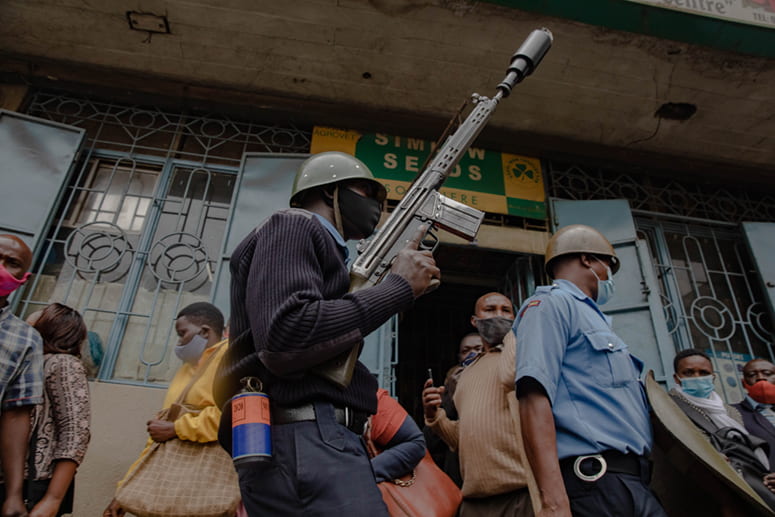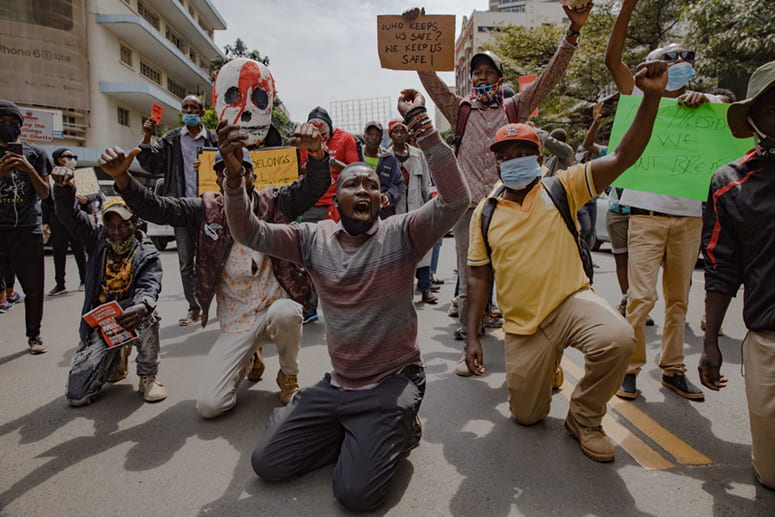
Dialogue
Policing: War Institution or Public Service?
By Douglas Lucas Kivoi
Statistics indicate that a Black person in the United States is 3.23 times more likely to be killed when they encounter a police officer than a white person.1 In Kenya, a poor person is highly likely to be killed or brutalized by the police in any given encounter. In both cases, the statistics hold true regardless of whether or not the individuals have committed a crime.
Policing is not a war institution. It is a service institution. Yet when we look around, both in the United States and in Kenya, we see police officers in armored personnel carriers, in heavy, bulletproof vests, carrying heavy rifles or even machine guns. In Kampala, Uganda, for instance, it is normal to see a police officer carrying a machine gun in the streets. It is normal to see AK-47s, M-16s, M-14s, and grenades in the hands of police officers. These are weapons of war and not policing gear.
So, is this public service, or is this a war institution? Is it public service when the SWAT team is used to arrest someone in the United States who has jumped bail? Is it public service when poor people in Kenya, unable to bribe the police, get killed?
The United States of America is the biggest exporter of global police militarization to the rest of the world. In my country, some units of our police force are trained by Delta Force, a special operations force of the U.S. Army. Others are trained by Navy SEALs. Delta Force and the SEALs are not police units; these are military units. And our police force is given military hardware equipment, mostly from the U.S military, under the pretext of fighting terror.

The Kenyan police respond to the protests in Nairobi with weapons and tear gas. Photo by Ed Ram
What are the causes of this global militarization? One cause is the global war on terror. Countries have used the threat of terrorism to militarize their policing units, and, in the end, the same tactics meant for the battlefields are used on unarmed civilians. They’re using them when dealing with civilians, some of whom are just protesting peacefully. That should not be the case. A second cause is the war on narcotics. Police forces around the world—including in Kenya—are trained by American units to fight the war on drugs. They are given armored personnel carriers, machine guns, drones, and even tanks. In Kenya, drug dealers don’t stay in bushes or in forests—they stay in communities. If police officers are given tanks and grenade launchers to deal with drug dealers who reside in communities, they are basically being told that they can use these weapons on unarmed civilians who may be minding their own business or who are caught in the fire fights.
We can also trace militarization to the training curriculum. The training curricula of police institutions across the globe are extremely problematic and archaic. In the United States, soldiers are employed to work as police officers—people who are trained as military men and military women. And they continue to use the same equipment they used in the military. Now, in Africa, most police officers in the streets patrol with AK-47 rifles, G3 rifles, or M-16s. You hardly ever see them with handguns. What is a police officer doing within a community with an AK-47 rifle, with a G3, with an M-16? These are problems in police training curricula around the world.
What are the consequences of this militarization of police institutions across the globe? One dangerous consequence is police arrogance, especially with white police officers in the United States. In Kenya, most police officers are very arrogant and do not handle challenges to their authority well. If you question what they are doing, you will be shot. This arrogance leads to the violation of basic fundamental rights of citizens, unnecessary legal sanctions on poor people, and, in the United States, unnecessary traffic stops for Black people and people of color. We also see crime prevention being militarized. In Kenya, if a crime happens in a particular neighborhood, the police will come in with their trucks and round up people—sometimes whole communities—for interrogation. These people might be held for months or even years before being released. Others simply disappear without a trace. All of these factors have contributed to the decline in public trust in policing institutions. This makes it extremely difficult for police officers to serve communities—the level of trust is very, very low.

A group of protestors advocates against police brutality in Nairobi. One sign reads “Who keeps us safe? We keep us safe!” Photo by Ed Ram
Given all of these consequences, what needs to change? First of all, police officers themselves. Change must come from within the policing institutions across the globe. We cannot force them to change if they don’t want to change. In addition, we need to look into community policing. Communities know where the drug dealers are. They know where the kidnappers stay; they know where the human traffickers stay. They don’t need military tanks and helicopters to identify and isolate these bad apples within their communities. We also need to increase police accountability within each country. In Kenya, we have the Internal Affairs Unit (IAU) within the police. We have the Independent Police Oversight Authority (IPOA). But these institutions don’t always work as they are supposed to, due to external interference. In fact, researchers have suggested that American police unions are the biggest obstacle to reform and accountability, because they protect rogue elements within police departments. And, finally, we need to shift law enforcement to be seen as a service, not as a war. Law enforcement is a public service.
When it comes to policing, each country has its own set of unique challenges. But we need to have a global voice and say that enough is enough. We in Africa are disgusted when we see Black people in the United States of America being shot and brutalized because of their skin color. That should not be the case. Those Black people who are in the United States of America were taken there by force. They were slaves. And they have the right to enjoy the life they have in the United States. They have a right to live in dignity as opposed to being stigmatized because of their color. And, as citizens of the globe, we have to come together and work toward combatting the global militarization of police. We need to have a humane policing framework that respects the lives of citizens and ensures that people live in dignity.
Douglas Lucas Kivoi holds a PhD in ethics and African philosophy from the University of Nairobi, Kenya. He currently works as the principal policy analysis for the Kenya Institute for Public Policy and Research Analysis, Governance Department.
Please follow our Commentary Guidelines when engaging in discussion on this site.

